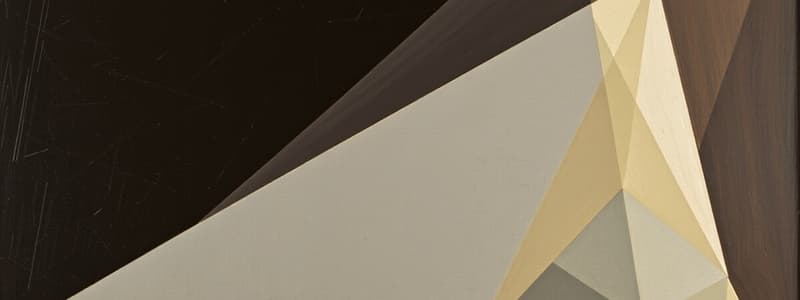Podcast
Questions and Answers
What is the sum of the interior angles of a triangle?
What is the sum of the interior angles of a triangle?
- 270 degrees
- 360 degrees
- 180 degrees (correct)
- 90 degrees
Which type of geometry includes the study of curved surfaces?
Which type of geometry includes the study of curved surfaces?
- Euclidean Geometry
- Analytic Geometry
- Non-Euclidean Geometry (correct)
- Projective Geometry
What formula is used to calculate the area of a circle?
What formula is used to calculate the area of a circle?
- A = 2πr
- A = πr² (correct)
- A = r²
- A = πr
In which type of geometric transformation does a shape maintain its proportions while resizing?
In which type of geometric transformation does a shape maintain its proportions while resizing?
According to the Triangle Inequality theorem, what must be true about the lengths of sides in a triangle?
According to the Triangle Inequality theorem, what must be true about the lengths of sides in a triangle?
What is the volume formula for a cylinder?
What is the volume formula for a cylinder?
Which type of triangle has all sides of equal length?
Which type of triangle has all sides of equal length?
Which geometric concept is represented by a straight path extending infinitely in both directions?
Which geometric concept is represented by a straight path extending infinitely in both directions?
Flashcards are hidden until you start studying
Study Notes
Basics of Geometry
- Definition: Geometry is the branch of mathematics that deals with shapes, sizes, and properties of space.
- Key Concepts:
- Points: No dimensions, represented by a dot.
- Lines: Straight paths extending infinitely in both directions, with no thickness.
- Line Segments: Part of a line bounded by two endpoints.
- Rays: Part of a line that starts at one point and extends infinitely in one direction.
Types of Geometry
-
Euclidean Geometry:
- Based on flat surfaces.
- Key postulates include the concept of parallel lines and the Pythagorean theorem.
-
Non-Euclidean Geometry:
- Includes hyperbolic and elliptic geometry.
- Deals with curved surfaces and different properties of parallel lines.
-
Analytic Geometry:
- Combines algebra and geometry using a coordinate system.
- Involves graphs, equations of lines, and conic sections.
-
Projective Geometry:
- Studies properties invariant under projection.
- Focuses on properties of figures that remain unchanged through projection.
Fundamental Shapes
-
Triangles:
- Types: Equilateral, Isosceles, Scalene.
- Sum of angles: 180 degrees.
-
Quadrilaterals:
- Types: Squares, Rectangles, Parallelograms, Trapezoids.
- Sum of interior angles: 360 degrees.
-
Circles:
- Defined by a center and radius.
- Key formulas:
- Circumference: C = 2πr
- Area: A = πr²
Key Theorems
- Pythagorean Theorem: In a right triangle, a² + b² = c², where c is the hypotenuse.
- Triangle Inequality: The sum of the lengths of any two sides of a triangle must be greater than the length of the third side.
Geometric Transformations
- Translation: Moving a shape without rotating or flipping it.
- Rotation: Turning a shape around a fixed point.
- Reflection: Flipping a shape over a line.
- Dilation: Resizing a shape while keeping its proportions.
Area and Volume Formulas
-
Area:
- Triangle: A = 1/2 * base * height
- Rectangle: A = length * width
- Circle: A = πr²
-
Volume:
- Cube: V = side³
- Cylinder: V = πr²h
- Sphere: V = 4/3πr³
Applications of Geometry
- Used in various fields including architecture, engineering, physics, and computer graphics.
- Fundamental in real-world problem-solving and spatial reasoning.
Basics of Geometry
- Geometry studies shapes, sizes, and spatial properties.
- Points: Represented by dots without dimensions.
- Lines: Infinite straight paths that have no thickness.
- Line Segments: Portions of lines defined by two endpoints.
- Rays: Lines that start at a point and extend infinitely in one direction.
Types of Geometry
- Euclidean Geometry:
- Concerns flat surfaces with fundamental concepts like parallel lines and the Pythagorean theorem.
- Non-Euclidean Geometry:
- Involves hyperbolic and elliptic geometries, focusing on curves and unique properties of parallel lines.
- Analytic Geometry:
- Merges algebra with geometry, utilizing a coordinate system for graphing and deriving equations for lines and conic sections.
- Projective Geometry:
- Explores properties of figures that remain invariant under projection transformations.
Fundamental Shapes
- Triangles:
- Types include equilateral, isosceles, and scalene; all triangles have an angle sum of 180 degrees.
- Quadrilaterals:
- Types such as squares, rectangles, parallelograms, and trapezoids; their interior angles sum to 360 degrees.
- Circles:
- Defined by a center and a radius; key formulas are:
- Circumference: ( C = 2\pi r )
- Area: ( A = \pi r^2 )
- Defined by a center and a radius; key formulas are:
Key Theorems
- Pythagorean Theorem: States that in a right triangle, the relationship ( a^2 + b^2 = c^2 ) holds true, where ( c ) is the hypotenuse.
- Triangle Inequality: The lengths of any two sides of a triangle must exceed the length of the remaining side.
Geometric Transformations
- Translation: Moves shapes without rotation or flipping.
- Rotation: Revolves shapes around a fixed point.
- Reflection: Flips shapes over a designated line.
- Dilation: Resizes shapes proportionally while maintaining their dimensions.
Area and Volume Formulas
-
Area Formulas:
- Triangle: ( A = \frac{1}{2} \times \text{base} \times \text{height} )
- Rectangle: ( A = \text{length} \times \text{width} )
- Circle: ( A = \pi r^2 )
-
Volume Formulas:
- Cube: ( V = \text{side}^3 )
- Cylinder: ( V = \pi r^2 h )
- Sphere: ( V = \frac{4}{3} \pi r^3 )
Applications of Geometry
- Geometry is crucial in fields such as architecture, engineering, physics, and computer graphics.
- It plays a key role in solving real-world problems and enhancing spatial reasoning skills.
Studying That Suits You
Use AI to generate personalized quizzes and flashcards to suit your learning preferences.




